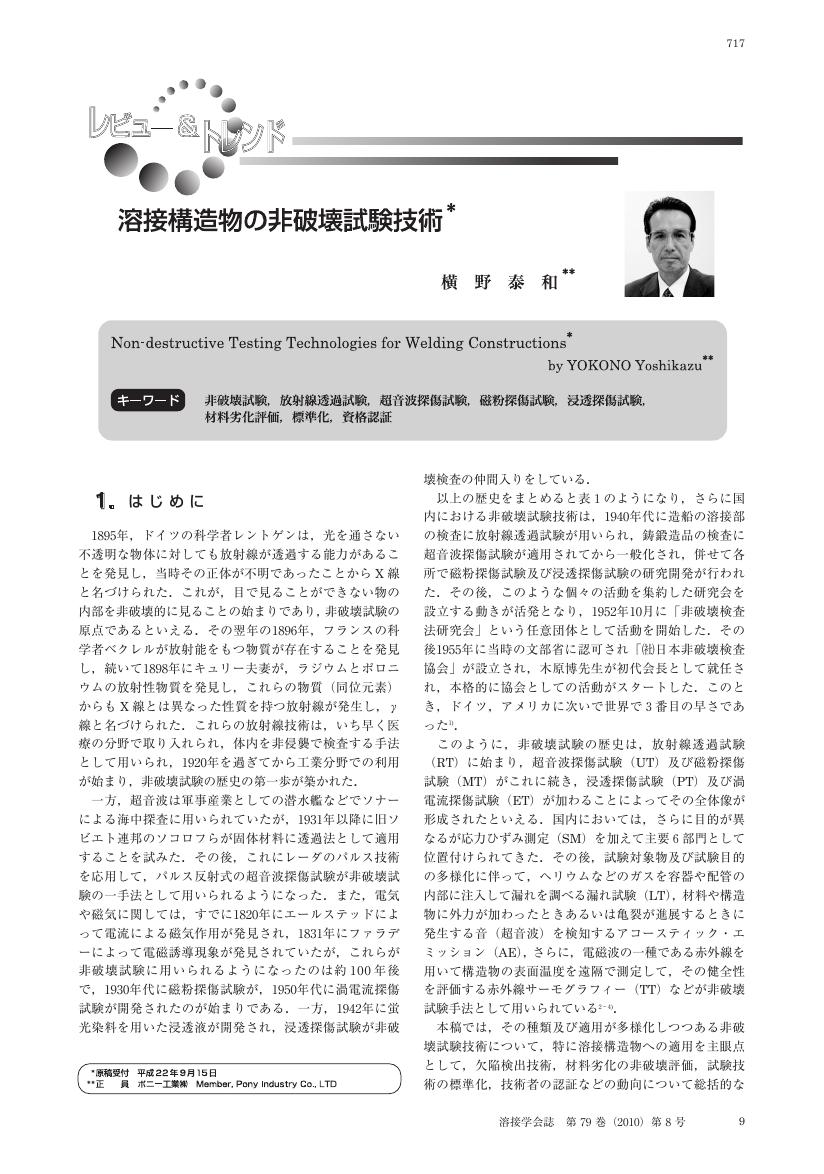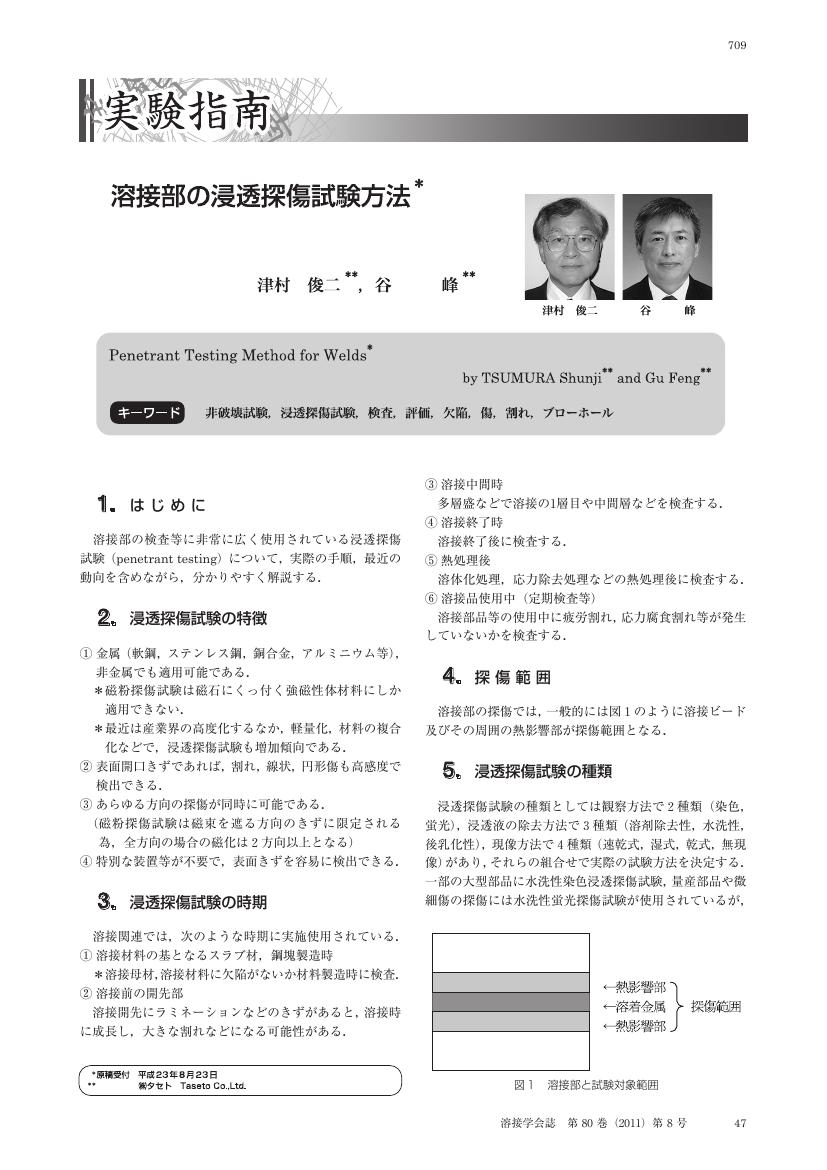1 0 0 0 軟鑞接の研究(第1報):銅錫間の反応について
- 著者
- 川崎 獺雄
- 出版者
- 一般社団法人 溶接学会
- 雑誌
- 溶接学会誌 (ISSN:00214787)
- 巻号頁・発行日
- vol.29, no.2, pp.122-127, 1960
- 被引用文献数
- 3
This report is researched for the microstructure of joints, which are prepared by the soaking of the copper rods in the bath of molten tin, tin-lead alloy of eutectic composition and in tin powder with flux.<BR>1) The eutectoid temperature of Cu<SUB>31</SUB>Sn<SUB>8</SUB> (δ) is 330°C-380°C It is recognized that δ is not formed at the Cu-Sn interface at the above temperature interval even for 30hr-70hr, but Cu<SUB>3</SUB>Sn is formed and contacts with Cu. But at 400°C δ contacts with Cu.<BR>2) When Cu-Sn is heated for very short time at 50°C-100°C above the melting point of Sn, Cu<SUB>3</SUB> So and Cu<SUB>6</SUB>Sn<SUB>5</SUB> are always formed and Cu<SUB>3</SUB>Sn contacts with Cu, Cu<SUB>6</SUB>Sn<SUB>5</SUB> contacts with Cu<SUB>3</SUB>Sn. Therfore it is thought that these compounds have the important influence on soldering of copper by soft solder and play on important part. Up to now it has been thought that these compounds are not recognized when soldering time is very short.<BR>The microstructure of vertical section alone of solder joins have been studied, but the microstructure of the inclined plane of joins have been not observed, therefore these compounds have been passed over, because there very thin.<BR>3) The microstructure and microhardness of these compounds by the diffusion are same with those of the Cu<SUB>31</SUB>Sn<SUB>8</SUB>, Cu<SUB>3</SUB>Sn and Cu<SUB>6</SUB>Sn<SUB>5</SUB> phase by melting. The Vickers microhardness of Cu<SUB>31</SUB>Sn<SUB>8</SUB>, Cu<SUB>3</SUB>Sn and Cu<SUB>6</SUB>Sn<SUB>5</SUB> are about 590, 530 and 460.<BR>4) Between copper and solid tin are formed these compands Cu<SUB>3</SUB>Sn, Cu<SUB>6</SUB>Sn<SUB>5</SUB> by diffusion below melting temperature of tin.<BR>5) The free energy of activation calculated from the deposition of tin on copper and brass with flux are 12970cal/g. atom and 12930ca1/g.atom.
1 0 0 0 OA 液体金属の物性(III) 液体金属の輸送的性質:粘性と拡散
- 著者
- 飯田 孝道
- 出版者
- 一般社団法人 溶接学会
- 雑誌
- 溶接学会誌 (ISSN:00214787)
- 巻号頁・発行日
- vol.63, no.2, pp.70-75, 1994-03-05 (Released:2011-08-05)
- 参考文献数
- 11
- 被引用文献数
- 3 3
- 著者
- 関野 昭幸
- 出版者
- 一般社団法人 溶接学会
- 雑誌
- 溶接学会誌 (ISSN:00214787)
- 巻号頁・発行日
- vol.61, no.3, pp.158-162, 1992
1 0 0 0 OA 4-4 溶接・接合部の非破壊試験法と検査
- 著者
- 横野 泰和
- 出版者
- 一般社団法人 溶接学会
- 雑誌
- 溶接学会誌 (ISSN:00214787)
- 巻号頁・発行日
- vol.78, no.3, pp.213-223, 2009 (Released:2014-02-12)
- 参考文献数
- 17
- 被引用文献数
- 1 1
1 0 0 0 溶接・接合部の非破壊試験法と検査
- 著者
- 横野 泰和
- 出版者
- 一般社団法人 溶接学会
- 雑誌
- 溶接学会誌 = Journal of the Japan Welding Society (ISSN:00214787)
- 巻号頁・発行日
- vol.78, no.3, pp.213-223, 2009-04-05
- 参考文献数
- 17
- 被引用文献数
- 1 1
1 0 0 0 切欠きと非破壊検査
- 著者
- 加藤 光昭
- 出版者
- 一般社団法人 溶接学会
- 雑誌
- 溶接学会誌 = Journal of the Japan Welding Society (ISSN:00214787)
- 巻号頁・発行日
- vol.81, no.4, pp.229-234, 2012-06-05
- 参考文献数
- 10
1 0 0 0 非破壊検査による表面欠陥の検出と評価
- 著者
- 横野 泰和
- 出版者
- 社団法人溶接学会
- 雑誌
- 溶接学会誌 = Journal of the Japan Welding Society (ISSN:00214787)
- 巻号頁・発行日
- vol.66, no.2, pp.86-89, 1997-03-05
- 参考文献数
- 12
1 0 0 0 OA 非破壊検査の種類と特徴
- 著者
- 横野 泰和
- 出版者
- 一般社団法人 溶接学会
- 雑誌
- 溶接学会誌 (ISSN:00214787)
- 巻号頁・発行日
- vol.59, no.6, pp.410-413, 1990-09-05 (Released:2011-08-05)
- 参考文献数
- 26
- 被引用文献数
- 2 2
1 0 0 0 OA 溶接構造物の非破壊試験技術
- 著者
- 横野 泰和
- 出版者
- 一般社団法人 溶接学会
- 雑誌
- 溶接学会誌 (ISSN:00214787)
- 巻号頁・発行日
- vol.79, no.8, pp.717-732, 2010 (Released:2014-02-22)
- 参考文献数
- 84
- 被引用文献数
- 2 2
1 0 0 0 OA 非破壊検査による表面欠陥の検出と評価
- 著者
- 横野 泰和
- 出版者
- 一般社団法人 溶接学会
- 雑誌
- 溶接学会誌 (ISSN:00214787)
- 巻号頁・発行日
- vol.66, no.2, pp.86-89, 1997-03-05 (Released:2011-08-05)
- 参考文献数
- 12
1 0 0 0 OA 溶接部の浸透探傷試験方法
- 著者
- 津村 俊二 谷 峰
- 出版者
- 一般社団法人 溶接学会
- 雑誌
- 溶接学会誌 (ISSN:00214787)
- 巻号頁・発行日
- vol.80, no.8, pp.709-712, 2011 (Released:2013-02-21)
- 参考文献数
- 1
- 被引用文献数
- 1
1 0 0 0 溶接構造物の非破壊試験技術
- 著者
- 横野 泰和
- 出版者
- 溶接学会
- 雑誌
- 溶接学会誌 = Journal of the Japan Welding Society (ISSN:00214787)
- 巻号頁・発行日
- vol.79, no.8, pp.717-732, 2010-12-05
- 参考文献数
- 84
1 0 0 0 溶接部の浸透探傷試験方法
- 著者
- 津村 俊二 谷 峰
- 出版者
- 溶接学会
- 雑誌
- 溶接学会誌 = Journal of the Japan Welding Society (ISSN:00214787)
- 巻号頁・発行日
- vol.80, no.8, pp.709-712, 2011-12-05
- 参考文献数
- 1
1 0 0 0 OA 切欠きと非破壊検査
- 著者
- 加藤 光昭
- 出版者
- 一般社団法人 溶接学会
- 雑誌
- 溶接学会誌 (ISSN:00214787)
- 巻号頁・発行日
- vol.81, no.4, pp.229-234, 2012 (Released:2015-02-05)
- 参考文献数
- 10
1 0 0 0 非破壊検査の種類と特徴
- 著者
- 横野 泰和
- 出版者
- 社団法人溶接学会
- 雑誌
- 溶接学会誌 (ISSN:00214787)
- 巻号頁・発行日
- vol.59, no.6, pp.p410-413, 1990-09
- 被引用文献数
- 9
1 0 0 0 OA 米国海軍駆逐艦の熔接順予について(II)
- 著者
- 吉田 俊夫
- 出版者
- 一般社団法人 溶接学会
- 雑誌
- 溶接学会誌 (ISSN:00214787)
- 巻号頁・発行日
- vol.24, no.10, pp.397-402, 1955 (Released:2009-06-12)
- 参考文献数
- 2
1 0 0 0 OA 米国海軍駆逐艦の熔接順序について(I)
- 著者
- 吉田 俊夫
- 出版者
- 一般社団法人 溶接学会
- 雑誌
- 溶接学会誌 (ISSN:00214787)
- 巻号頁・発行日
- vol.24, no.8-9, pp.337-342, 1955 (Released:2009-06-12)
1 0 0 0 OA 4 医療への接着剤の応用
- 著者
- 林 壽郎
- 出版者
- 一般社団法人 溶接学会
- 雑誌
- 溶接学会誌 (ISSN:00214787)
- 巻号頁・発行日
- vol.70, no.2, pp.257-261, 2001-03-05 (Released:2011-08-05)
- 参考文献数
- 29
- 被引用文献数
- 1
1 0 0 0 OA ポリエチレンの酸化と接着性に関する研究
- 著者
- 井町 正樹
- 出版者
- 一般社団法人 溶接学会
- 雑誌
- 溶接学会誌 (ISSN:00214787)
- 巻号頁・発行日
- vol.43, no.2, pp.127-134, 1974-02-25 (Released:2011-08-05)
- 参考文献数
- 14
One of the principal problems in using polyethylene is the poor adhesion because of its nonpolarity and high crystallinity. There are various methods for surface treatment to improve adhesiveness of polyethylene and many ofthem are applied on purpose to make polyethylene oxydized and polarized.Relation between treatment conditions and adhesiveness or the effect of oxydation are not sufficiently clear. In this study, low density polyethylene film was exposed to pure oxygen gas under a pressure of 20kg/cm2-80kg/cm2 at 80°C-110°C for 5hours-30hours, and then degree of oxydation, wettability, adhesiveness and others were investigated. The effect of chromic acid treatment which is popularly used on account of its convenience was also examined.The results are summarized as follows:(1) Oxygen gas treatment even at a temperature below the melting point of polyethylene is somewhat effective on wettability and adhesiveness and more effective at a temperature above the melting point.(2) The adhesive strength of polyethylene increases owing to oxygen gas treatment but shows a decreasing tendency in excessive oxydation. One of the factors which cause this fact seems to be the weak boundary layer fomed with the advance of oxydation.(3) It becomes clear that the effect of only oxydation on adhesiveness is not so remarkable, i.e. polyethylene surface subjected to oxygen gas treatment dose not exhibit more increase in adhesive strength than that treated with chromic acid which is considered to be attended with some factors such as surface roughness in addition to oxydation.
1 0 0 0 関西国際空港連絡橋復旧工事
- 著者
- 引口 学
- 出版者
- 一般社団法人 溶接学会
- 雑誌
- 溶接学会誌 (ISSN:00214787)
- 巻号頁・発行日
- vol.90, no.3, pp.171-175, 2021









